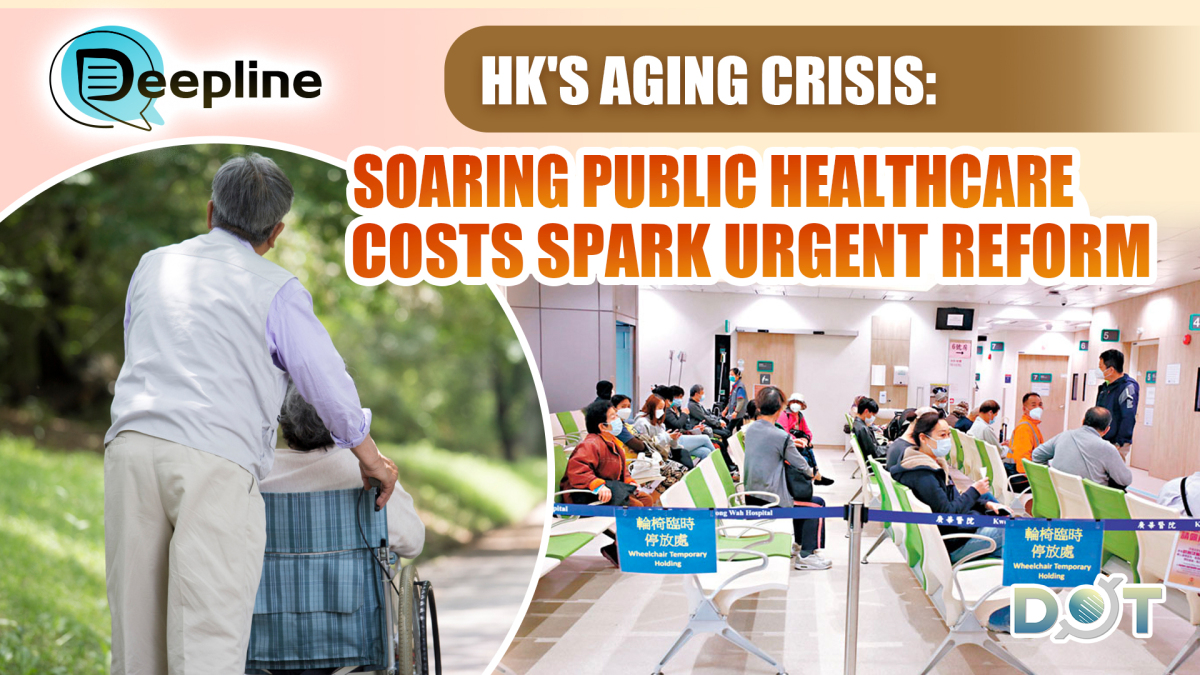
Under Hong Kong's aging population, public medical expenditure has increased significantly. The SAR government's Health Bureau yesterday (Oct. 16) released the 2023/24 Current Health Expenditure (CHE) showing that the current health expenditure for that financial year reached HK$251.207 billion, an increase of approximately HK$20 billion compared to the previous year (excluding COVID-19 related expenditure), representing an 8.6% rise. Nearly 52% was used for the public healthcare system, doubling over ten years.
As the elderly population increases from 1.64 million to 2.44 million by 2036, the healthcare system faces severe challenges. Regarding the fee increases for medications and accident and emergency services at public hospitals starting next year, the Health Bureau emphasized that the adjustments would have little effect on increasing revenue, but any additional income would be fully reinvested into the public healthcare system.
Eva Tsui, Chief Data Scientist (Data Analytics) of the Health Bureau, noted in her analysis yesterday that in the 2023/24 recurrent health expenditure, public healthcare accounted for 51.8% (HK$130.072 billion), constituting 4.3% of the Gross Domestic Product (GDP). This is 1.5 times the 2.9% share from ten years ago, a growth rate similar to the increase in the proportion of the population aged 65 and above during the same period. This reflects that population aging is one of the main factors driving this increase.
Currently, the public, especially the elderly, heavily relies on the inpatient and day inpatient services of the public healthcare system. According to statistics, the average total inpatient days per thousand elderly population is 5.3 times that of the non-elderly population. The per capita service cost of the Hospital Authority for the elderly population is 4.3 times that for the non-elderly population.
Hong Kong's elderly population will increase from 1.64 million in mid-2023 to 2.44 million in mid-2036, and is projected to reach 2.75 million by mid-2046. With the continuous aging of the population and the increase in chronic diseases, the sustainability of Hong Kong's healthcare system, particularly the public healthcare system, will face numerous challenges.
Raymond Wu, Deputy Secretary for Health, said that as the medical costs for the elderly are higher than for younger people, their hospitalization rate is also higher.
"An increase in medical expenditure inevitably follows this trend, but how will this trend develop? Fast or slow? How high or how much?"
Over 90% of citizens rely on public hospital inpatient services
Regarding private healthcare expenditure, in the 2023/24 financial year, it accounted for 48.2% (HK$121.135 billion) of Hong Kong's recurrent health expenditure, representing 4% of GDP. Over the past decade, the proportion of privately purchased health insurance and employer-provided medical insurance plans within private expenditure has increased from 33.4% to 44.8%, making them an increasingly important source of funding for private medical services.
The Voluntary Health Insurance Scheme (VHIS), launched by the SAR Government in April 2019, had reached 1.428 million policies by the end of last year. However, the VHIS has not been able to change the public's tendency to seek treatment at public hospitals. Nearly 92% of citizens rely on public hospital inpatient services, while only about 8% choose private hospitals.
To enhance the sustainability of Hong Kong's healthcare system, Wu said that the government is comprehensively deepening the reform of the healthcare system. This includes actively developing primary healthcare to reverse the "treatment-oriented, prevention-light" healthcare system, better leveraging the role of family doctors in prevention, diagnosis, treatment, and management of chronic diseases, and reducing or delaying the use of more expensive secondary and tertiary healthcare services (including acute and convalescent inpatient services; complex and expensive hospital care services).
Enhancing transparency of private healthcare charges
Simultaneously, they are enhancing the transparency of charges for private medical services. Wu said, "Next year, through some legislative provisions, we hope to increase the transparency of the level of charges for private medical services. Coupled with the VHIS, we hope the two can work together, enabling more people who have the means to choose to use private services, thereby alleviating the burden on the public sector."
Regarding the reform of public healthcare charges, he emphasized striving to accurately subsidize patients in need through the reform.
"The current subsidy level for public healthcare charges is about 97.6%. It is estimated that after the first phase of charge reform is implemented in 2026, the subsidy rate will decrease to 94%. The additional revenue obtained as a result will be fully invested into the public healthcare system, so the overall expenditure of the government will not actually see any reduction because of this."
The government will also strengthen the promotion of primary healthcare, with related expenditure increasing to HK$73.5 billion, accounting for nearly 30% of total medical expenditure, aiming to change the "treatment-oriented, prevention-light" healthcare system.
Suggestions from medical groups
Facing the challenges of an aging population and rising medical costs, some Hong Kong medical groups believe that although future medical expenditures will inevitably increase, controlling the rate of growth of medical expenditure is a key focus the government needs to address.
Wong, President of a Hong Kong medical association, explained in an interview with Wen Wei Po that primary healthcare is the first level of the entire healthcare system, the initial point of contact for individuals and families in the continuous healthcare process. Through a district-based community healthcare system, citizens can detect chronic diseases early, and with the assistance of community healthcare service providers, specific chronic diseases can be intervened and managed promptly at the community level.
"This can act as a gatekeeper for the secondary and tertiary specialist medical services of hospitals and medical institutions and reduce relative pressures, such as pressure on hospital beds and manpower."
He also noted that the VHIS, fully implemented since 2019, aims to provide citizens with an additional option. Using private medical services through hospital insurance can also alleviate the government's healthcare burden.
(Source: Wen Wei Po; Journalist: Lee Tsz-shan; English Editor: Darius)
Related News:
Deepline | The hidden meal: Safety concerns rise as pre-made dishes become common in HK eateries




















Comment